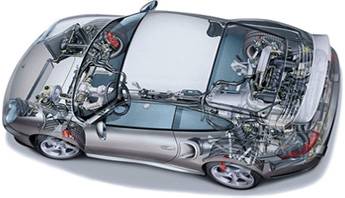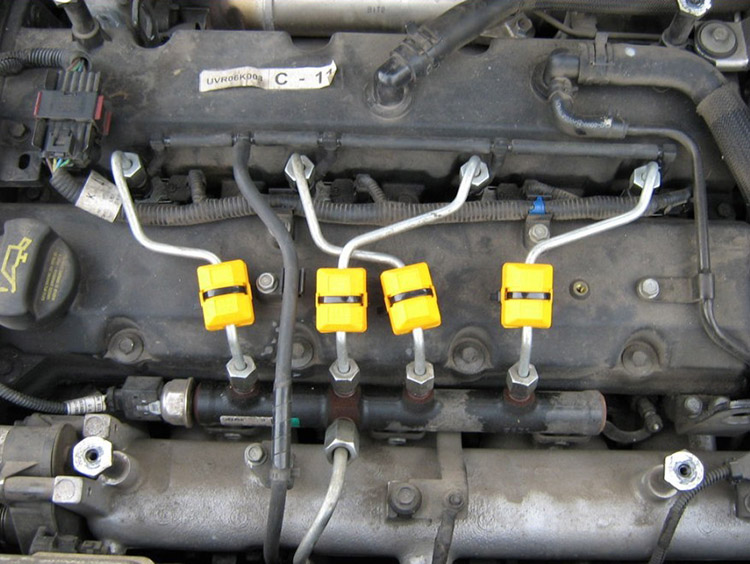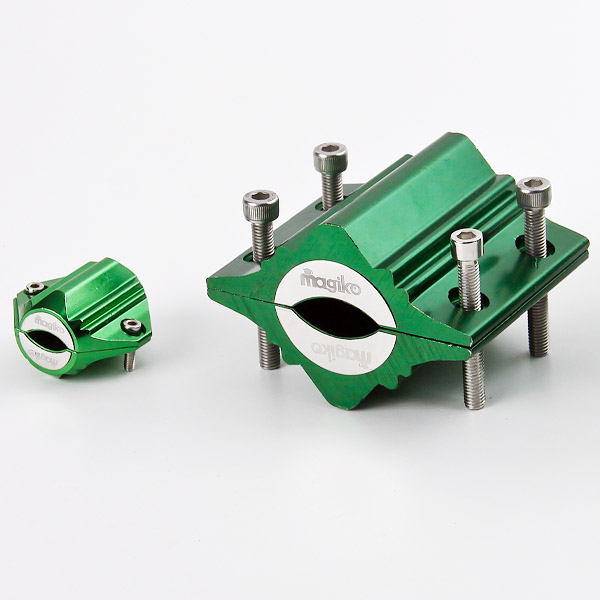Experimental study of magnetized fuel and air in diesel engine for energy saving and soot suppressing
Quote words
Due to the increasingly serious energy and environmental problems, higher requirements are put forward for the economy and exhaust emissions of the engine. When the engine is used, it must not only meet the economic and power requirements, but also meet the emission requirements, so the diesel engine saves oil and reduces smoke. Efficiency technology has always been one of the main goals of the internal combustion engine industry research. Regarding the research on the magnetization of internal combustion engine for fuel-saving and smoke-reducing technology, foreign countries began in the 1960s, and my country began in the 1980s. Foreign countries mainly studied the effect of engine exhaust emissions, while my country emphasizes the effect of fuel saving and power increase[1,2] . The commonly used magnetization method is to increase the magnetic field in the oil circuit system [3, 4]. This test is to increase the magnetic field in the oil circuit system and the air intake system to carry out the engine bench comparison test. By using different magnetic field strengths and different magnetization method combinations, the study After the fuel and air are magnetized, the impact on diesel engine power, economy and soot emission.
1 Test
The experiment was carried out on the S195 diesel engine, and its technical parameters were: cylinder diameter 95mm, stroke 115mm, calibrated power 8.8kW, engine speed 2000römin, compression ratio 22:1, pin injector, test oil is 0# diesel and 14# Diesel oil. During the test, the engine speed control handle is fixed at the position of the calibrated working condition, the original machine is measured for 12h power, and then under the same conditions, a magnetized fuel-saving device is installed for power measurement, and the load is gradually increased until the maximum torque appears, and the measurement is stable. Parameters such as speed, torque, fuel consumption and smoke value. The bench test setup is shown in Figure 1.
1.1 test device (1) D-150G hydraulic dynamometer (accuracy 1%); (2) SZG-20 handheld digital tachometer (accuracy 1‰); (3) volumetric fuel consumption meter (accuracy 1%); (4) FQD-102 smoke meter (accuracy 5%).
1.2 The magnetization treatment device of the magnetization equipment, as shown in Figure 2, the main magnetization equipment is: (1) CJ2I fuel-saving and smoke-reducing device (accuracy 1%, B=0.07~0.1T); (2) CJ2II fuel-saving and smoke reduction Device (B=0.03~0.05T); (3) Large magnetic ring (B=0.012~0.015T), small magnetic ring (B=0.005~0.007T)
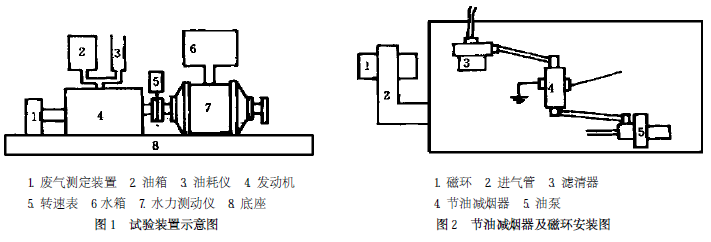
2 Test results and analysis
2.1 Test results: Different magnetic field strengths and different magnetization methods are used to study the engine speed control characteristics. During the test, the speed control handle is fixed at the maximum throttle condition. A total of 9 items are measured, and the speed, fuel consumption and fuel consumption under different loads are measured. For the smoke value and other values, each treatment is repeated 3 times and the average value is taken. The test results are listed in Table 1. The comparison curves of speed control characteristics under different working conditions are shown in Figure 3, Figure 4 and Figure 5.
2.2 Install the fuel-saving smoke reducer in the oil circuit and the filter. It can be seen from Figure 3 that when the CJ2I type fuel-saving smoke reducer is installed horizontally and vertically in the oil circuit, the specific fuel consumption, speed and smoke value of the engine change close , The effect of installing the CJ2I fuel-saving and smoke-reducing device is more obvious than that of the CJ2Ê. The fuel-saving and smoke-reducing effect has nothing to do with the installation position, but is directly related to the magnetic field strength. The magnetic field has a good fuel-saving effect. It can be seen from Table 1 that compared with ordinary diesel engines, the fuel consumption and smoke of the magnetized diesel engine are reduced, the speed is increased, the specific fuel consumption under the calibration conditions is reduced by 4.4% to 5.4%, the smoke is improved by 11.7% to 20.5%, and the speed is increased by 0.4%. ~0.6%. There are different opinions on the mechanism of magnetization, fuel saving and smoke reduction. Modern quantum mechanics believes that when the various motion states of molecules in a magnetic field are disturbed to a certain extent, their molecular microscopic state (molecular wave function and molecular energy level) changes, and the physical and chemical properties of the molecules are Conducive to the change of combustion direction [5], these are very beneficial to improve engine emissions and fuel consumption, so as to achieve the purpose of saving fuel, increasing power and reducing soot pollution.

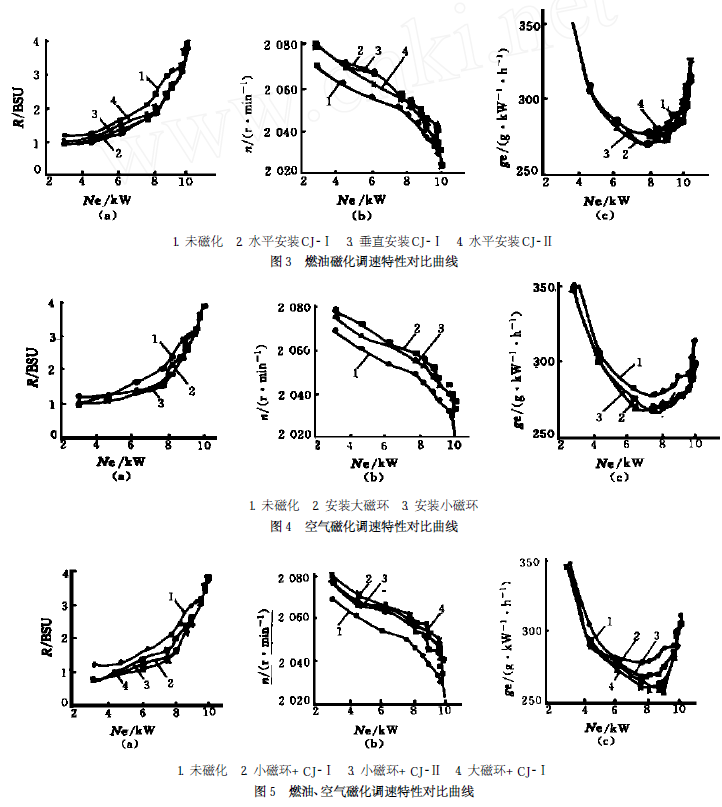
2.3 Installation of a magnetic ring in the intake duct It can be seen from Figure 4 that the installation of a large magnetic ring in the intake duct has a greater impact on the engine performance than a small magnetic ring, especially when the load is above 3 4 and at full load, the impact on the engine performance is particularly obvious. This is because the high-load internal combustion engine is an oxygen-deficient combustion. The installation of a magnetic ring in the intake pipe improves the oxygen content in the air and plays a role of oxygen gathering, so that the fuel is burned more fully in the combustion chamber. It can be seen from Table 1 that compared with ordinary engines, the engine with magnetic ring has reduced fuel consumption by 0.7% to 1.4%, improved smoke by 11.7% to 17.6%, and increased speed by 0.34% to 0.53%.
2.4 The simultaneous magnetization of fuel and air is shown in Figure 5. The magnetic field is added to the oil system and the air intake system respectively. It can be seen that the CJ2I enlarged magnetic ring has a better fuel-saving and smoke-reducing effect than the CJ2I plus small magnetic ring, indicating that the fuel and air The fuel-saving and smoke-reducing effect of the engine with simultaneous magnetization treatment is more obvious than that of a single magnetization treatment, and the magnetization effect of fuel and air is the best. It can also be seen from Figure 5 that the influence of the magnetic field strength on the engine performance is not linear. When the magnetic field strength rises to a certain value, the change tends to be relaxed. From the perspective of cost, the ideal magnetization method for the S195 diesel engine is a small magnetic ring plus CJ2I section. Oil smoke reducer. It can be seen from Table 1 that under the calibration conditions, compared with ordinary engines, the specific fuel consumption of the engine with both air and fuel magnetized at the same time is reduced by 3.6% to 5.0%, that is, 14gö (kW·h), and the smoke level of A is improved by 23.5% to 29.4. %, the speed is increased by 0.49%~0.78%.
3 Conclusion
(1) The effect of fuel-air magnetization on engine performance is different under different working conditions. Generally, the effect of fuel-saving, smoke-reducing and power-increasing under 3ö4 load and full load is significant, and changes are complicated under overload and low load conditions. .
(2) The influence of magnetic field strength on engine performance does not change linearly. When the magnetic field strength rises to a certain value, the change tends to relax. Therefore, the magnetic field strength is different for different types of engines.

